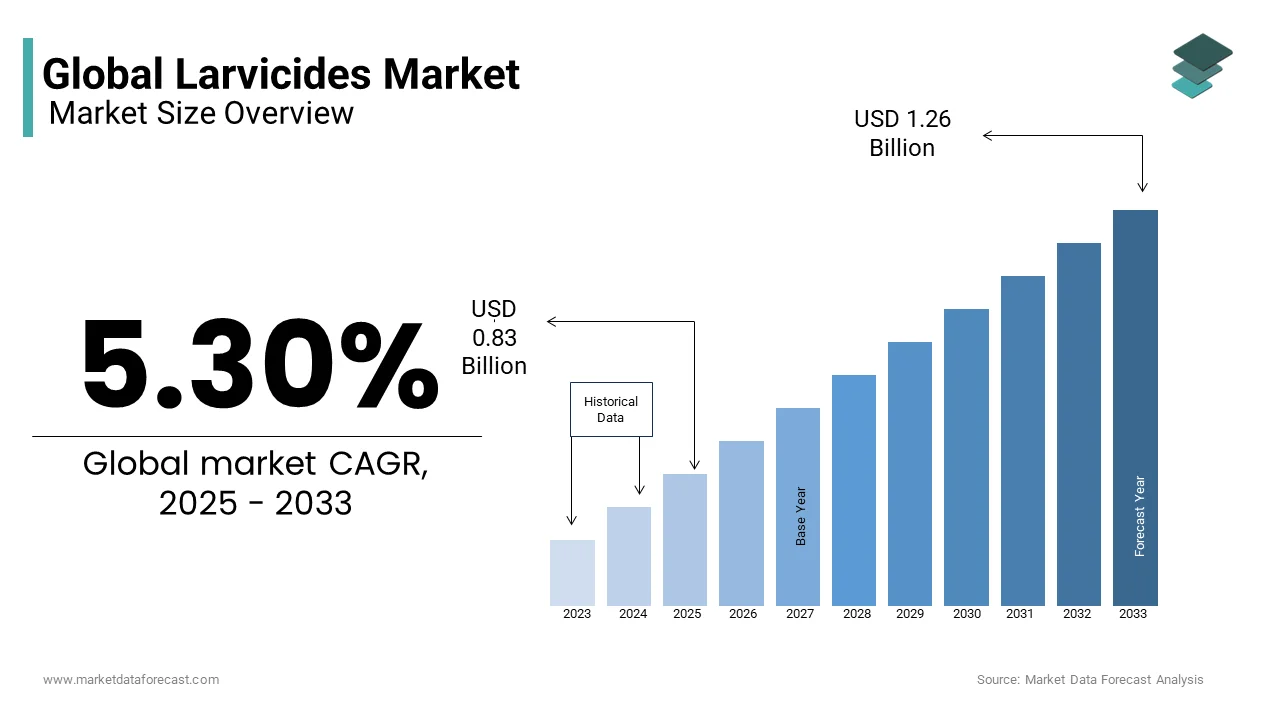Global Larvicides Market Size, Share, Trends & Growth Forecast Report, Segmented By Product (Synthetic, Natural And Biological Larvicides), Application (Government, Commercial And Residential Applications) And Region (North America, Europe, Asia Pacific, Latin America, Middle East And Africa), Industry Analysis From (2025 to 2033)
Global Larvicides Market Size
The global larvicides market was valued at USD 0.79 billion in 2024 and is anticipated to reach USD 0.83 billion in 2025 from USD 1.26 billion by 2033, growing at a CAGR of 5.30% during the forecast period from 2025 to 2033

Insecticides that are used to specifically target larvae of insects, preventing them from growing into adults, are known as larvicides. As mosquito is the most common foe for humans, larvicides are most used against them. Different larvicides kill larvae in different ways. They may be growth regulators, contact poisons, and stomach poisons.
Biological agents such as Bacillus species are also used to kill the larvae. Once the insects are exposed to the bacterium, they cannot digest the consumed food and eventually perish. Natural agents such as neem oil are very effective against insects. Research shows the efficiency rate is more than 95%. The application methods are to be carefully selected for applying larvicides. Spraying liquid larvicides is the most common method used. Care should be taken that harmful chemicals should not be mixed with stagnant water, which might be consumed by humans in the future.
MARKET DRIVERS
An increasing number of diseases, such as malaria and dengue, which are transmitted by mosquitoes, are the major factors driving the larvicides market. Increasing investments of governments in the prevention of mosquitoes in the residential areas, growing awareness among the population regarding the diseases spread by various insects, and availability of several options to kill the insects in the development stage are propelling the market growth. However, stringent regulations on the usage of larvicides and toxicity issues are restraining market growth.
REPORT COVERAGE
|
REPORT METRIC |
DETAILS |
|
Market Size Available |
2024 to 2033 |
|
Base Year |
2024 |
|
Forecast Period |
2025 to 2033 |
|
CAGR |
% |
|
Segments Covered |
By Product, Application, and Region. |
|
Various Analyses Covered |
Global, Regional & Country Level Analysis, Segment-Level Analysis, DROC, PESTLE Analysis, Porter’s Five Forces Analysis, Competitive Landscape, Analyst Overview of Investment Opportunities |
|
Regions Covered |
North America, Europe, APAC, Latin America, Middle East & Africa |
|
Market Leaders Profiled |
Valent BioSciences, Central Life Sciences, Bayer Environmental Science, BASF, Clarke, Kadant GranTek, Univa, UPL, Summit Chemical, and Others. |
SEGMENTAL ANALYSIS
By Product
Synthetic larvicides hold the largest market share due to their easy availability on a commercial scale. Due to the growing environmental concerns, the revenue of natural and biological larvicides is rapidly growing in the market.
By Application
Governments contribute to the majority of the revenue in the larvicides market. It is due to prevent several diseases that might be spread by insects.
REGIONAL ANALYSIS
The Asia Pacific leads the larvicides market due to the huge insect population, especially in the humid tropical parts of this region. Latin America is expected to be the fastest-growing market for larvicides. Developing countries such as Brazil, which can now afford to invest in preventing insect populations, are driving the market growth in this region.
KEY MARKET PLAYERS
Valent BioSciences, Central Life Sciences, Bayer Environmental Science, BASF, Clarke, Kadant GranTek, Univa, UPL, Summit Chemical. Some of the market players dominate the global larvicides market.
MARKET SEGMENTATION
This research report on the global larvicides market is segmented and sub-segmented into the following categories.
By Product
- Synthetic
- Natural
- Biological Larvicides
By Application
- government
- commercial
- residential
By Region
- North America
- Europe
- Asia Pacific
- Latin America
- Middle East and Africa
Related Reports
Access the study in MULTIPLE FORMATS
Purchase options starting from
$ 2500
Didn’t find what you’re looking for?
TALK TO OUR ANALYST TEAM
Need something within your budget?
NO WORRIES! WE GOT YOU COVERED!
Call us on: +1 888 702 9696 (U.S Toll Free)
Write to us: sales@marketdataforecast.com